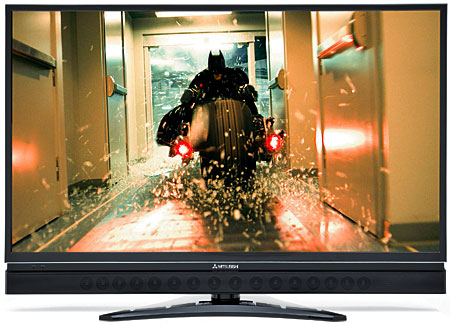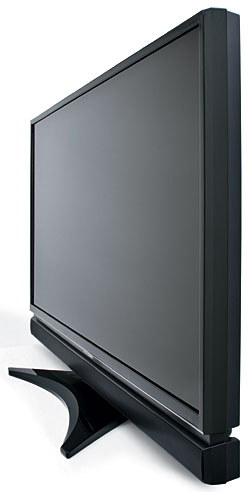Mitsubishi LT-52149 LCD HDTV
LCD Picture, Widescreen Sound
Many of today’s flat-panel HDTVs can look amazingly good. But when sets frequently offer similar features that differ mainly in name, it’s hard for any particular model to break loose from the yada, yada, yada sameness of the pack. That is, unless the manufacturer can convince the consumer that its Super Dynamic Image Enhancer is something he’s just gotta have.

With its new 52-inch LT-52149, Mitsubishi offers most of the latest buzzword thingamabobs: a 120-hertz panel refresh rate, HDMI 1.3, JPEG photo display through a USB jack, and interactive features that help it work and play well with other components. Apart from those interactivity features (which take up a big slice of the user manual), the set includes one unique bling of its own: Sound Projector technology. While most consumers look mainly for picture quality when they shop for a set, this feature may turn at least a few heads (or ears) in its direction.
Around the Block
The LT-52149 bears a striking physical resemblance to…most other flat-panel sets. Like many LCD designs, its screen is minimally reflective. Its frame is also thin, which acts as a style statement and accommodates placement in tight spaces.
The side panel has component (and shared composite) A/V connections and a USB port. The back panel houses the set’s four HDMI 1.3 inputs. The set even has a CableCARD slot.
 The multi-component remote is a good one, with (partial) backlighting and comfortably large buttons. It does not offer direct input selection, but the Input Selection menu only highlights inputs that are connected to sources.
The multi-component remote is a good one, with (partial) backlighting and comfortably large buttons. It does not offer direct input selection, but the Input Selection menu only highlights inputs that are connected to sources.
There are three picture modes: Brilliant, Bright, and Natural. A game mode is available only when you’ve named the selected input either Game or PC. You can adjust each of these modes individually and set the video controls separately for each input. The Natural mode produced the most accurate image (after adjustment), and I used it exclusively in my viewing tests.
The LT-52149 includes the usual aspect ratio options (Mitsubishi calls them formats). Full Native, the only option with zero overscan, is available only in 1080i and 1080p. The set doesn’t provide picture-in-picture capability.
There are two color temperature settings, high and low. The user menus don’t offer any other controls to calibrate the set’s color temperature, and the service menu offers only limited calibration controls.
Mitsubishi’s PerfectColor system provides a single control for each of the primary and secondary colors. Since the Natural mode produced a very accurate color gamut, I left these controls at their factory (centered) positions.
 While the set accepts a 1080p/24 input, it does not keep it in that form (or a direct multiple of 24 fps) all the way to the display. Instead, it first converts 1080p/24 to 1080p/60 by adding 3:2 pulldown (which eliminates the main benefits of a 24-fps source). To match the panel’s 120-Hz refresh rate, it then further converts the signal to 1080p/120. It converts other source resolutions (480i/p, 1080i, 720p) to 1080p/60 and then upconverts them to 1080p/120.
While the set accepts a 1080p/24 input, it does not keep it in that form (or a direct multiple of 24 fps) all the way to the display. Instead, it first converts 1080p/24 to 1080p/60 by adding 3:2 pulldown (which eliminates the main benefits of a 24-fps source). To match the panel’s 120-Hz refresh rate, it then further converts the signal to 1080p/120. It converts other source resolutions (480i/p, 1080i, 720p) to 1080p/60 and then upconverts them to 1080p/120.
The set performs the upconversion from 60 Hz to 120 Hz differently depending on the Smooth 120Hz Film Motion control setting. Smooth 120Hz Film Motion is Mitsubishi’s take on the now widespread feature that runs an LCD panel at a 120-Hz refresh rate. With the right processing, this can reduce motion blur—a persistent concern with LCD displays.
Smooth 120Hz Film Motion offers three settings: Standard, High, and Off. In the Standard and High modes, the display brings the 1080p/60 signal (whether native to the source or upconverted as discussed above) up to 1080p/120. It does this by interpolating an extra frame from the content of the preceding and following frames in the existing program material. (The interpolation is more aggressive in the High setting.) With Smooth 120Hz Film Motion off, the set simply displays each 1080p/60 frame twice. Mitsubishi also applies a dejudder algorithm to film-based sources. The company designed the latter to compensate for the fact that the set’s video processing does not eliminate 3:2 pulldown when it’s present in the program material. It actually adds 3:2 pulldown when it isn’t there (on 24-fps material, as noted earlier).
The Mitsubishi’s Smooth 120Hz Film Motion does what it is designed to do: It reduces motion blur. My main complaint with 120-Hz motion compensation systems is that most of them (including this one) tend to make film-originated material look like it was shot on video—the soap opera look. The Mitsubishi’s inherent motion blur on most program material didn’t bother me, even with Smooth 120Hz Film Motion turned off—my preferred setting. But your mileage may vary.
Mitsubishi’s NetCommand IR system and NetCommand for HDMI provide for control of multiple components. NetCommand for HDMI operates only with compatible HDMI-connected devices.
Sound All Around
This set’s marquee feature is Mitsubishi’s Integrated Sound Projector (iSP) technology. It uses sixteen 1.6-inch (diameter) drivers with audio processing to simulate a conventional 5.1-channel surround sound system. To function properly, the system depends on wall reflections, and its controls let you tailor it to your listening space’s dimensions.
In a relatively lively 13-by-19-foot room, the iSP produced an almost eerie sensation of spaciousness. Images extended far to the left and right, well beyond the physical confines of the set. Ambience and diffuse effects like crowd noise (but not discrete effects on the program material I sampled) wrapped around me. How well it works will depend on your room and setup.
The iSP isn’t a substitute for a genuine surround sound system, but it certainly is an interesting and in some ways impressive feature. This could be a strong consideration if you don’t plan to use an outboard audio system.
Movie Time
The Mitsubishi produced an excellent color gamut in the Natural mode, with a very close match to the standard HD color points. But even after calibration, the Mitsubishi’s color tracking across the full brightness range was not particularly accurate. On darker scenes, fleshtones were sometimes tinted a little reddish-brown. Bright green foliage sometimes (but not always) looked a bit artificial. Closer to the top of the brightness range, for example, blue sky lacked the subtle shading of the real thing.
However, viewed on its own with real program material, the set’s color was far better and more believable than the above comments suggest. But when viewed side by side with a set with better color tracking, the Mitsubishi’s flaws were quite evident.
- Log in or register to post comments





























































